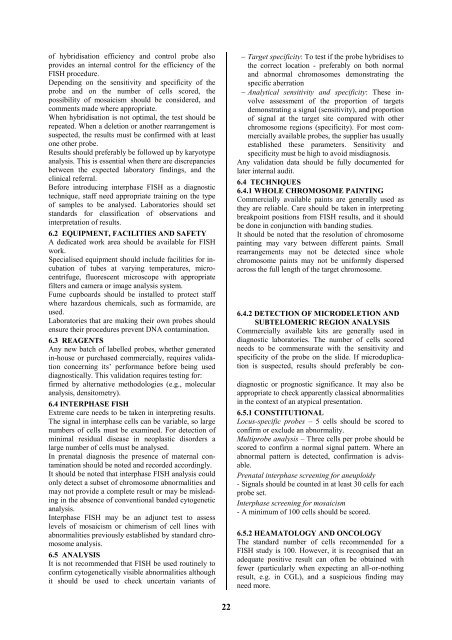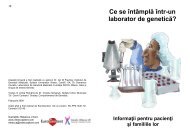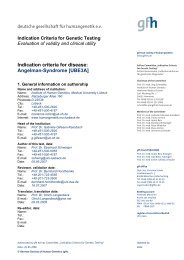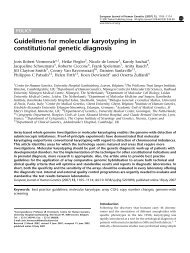Cytogenetic Guidelines and Quality Assurance - EuroGentest
Cytogenetic Guidelines and Quality Assurance - EuroGentest
Cytogenetic Guidelines and Quality Assurance - EuroGentest
You also want an ePaper? Increase the reach of your titles
YUMPU automatically turns print PDFs into web optimized ePapers that Google loves.
of hybridisation efficiency <strong>and</strong> control probe also<br />
provides an internal control for the efficiency of the<br />
FISH procedure.<br />
Depending on the sensitivity <strong>and</strong> specificity of the<br />
probe <strong>and</strong> on the number of cells scored, the<br />
possibility of mosaicism should be considered, <strong>and</strong><br />
comments made where appropriate.<br />
When hybridisation is not optimal, the test should be<br />
repeated. When a deletion or another rearrangement is<br />
suspected, the results must be confirmed with at least<br />
one other probe.<br />
Results should preferably be followed up by karyotype<br />
analysis. This is essential when there are discrepancies<br />
between the expected laboratory findings, <strong>and</strong> the<br />
clinical referral.<br />
Before introducing interphase FISH as a diagnostic<br />
technique, staff need appropriate training on the type<br />
of samples to be analysed. Laboratories should set<br />
st<strong>and</strong>ards for classification of observations <strong>and</strong><br />
interpretation of results.<br />
6.2 EQUIPMENT, FACILITIES AND SAFETY<br />
A dedicated work area should be available for FISH<br />
work.<br />
Specialised equipment should include facilities for incubation<br />
of tubes at varying temperatures, microcentrifuge,<br />
fluorescent microscope with appropriate<br />
filters <strong>and</strong> camera or image analysis system.<br />
Fume cupboards should be installed to protect staff<br />
where hazardous chemicals, such as formamide, are<br />
used.<br />
Laboratories that are making their own probes should<br />
ensure their procedures prevent DNA contamination.<br />
6.3 REAGENTS<br />
Any new batch of labelled probes, whether generated<br />
in-house or purchased commercially, requires validation<br />
concerning its’ performance before being used<br />
diagnostically. This validation requires testing for:<br />
firmed by alternative methodologies (e.g., molecular<br />
analysis, densitometry).<br />
6.4 INTERPHASE FISH<br />
Extreme care needs to be taken in interpreting results.<br />
The signal in interphase cells can be variable, so large<br />
numbers of cells must be examined. For detection of<br />
minimal residual disease in neoplastic disorders a<br />
large number of cells must be analysed.<br />
In prenatal diagnosis the presence of maternal contamination<br />
should be noted <strong>and</strong> recorded accordingly.<br />
It should be noted that interphase FISH analysis could<br />
only detect a subset of chromosome abnormalities <strong>and</strong><br />
may not provide a complete result or may be misleading<br />
in the absence of conventional b<strong>and</strong>ed cytogenetic<br />
analysis.<br />
Interphase FISH may be an adjunct test to assess<br />
levels of mosaicism or chimerism of cell lines with<br />
abnormalities previously established by st<strong>and</strong>ard chromosome<br />
analysis.<br />
6.5 ANALYSIS<br />
It is not recommended that FISH be used routinely to<br />
confirm cytogenetically visible abnormalities although<br />
it should be used to check uncertain variants of<br />
22<br />
Target specificity: To test if the probe hybridises to<br />
the correct location - preferably on both normal<br />
<strong>and</strong> abnormal chromosomes demonstrating the<br />
specific aberration<br />
Analytical sensitivity <strong>and</strong> specificity: These involve<br />
assessment of the proportion of targets<br />
demonstrating a signal (sensitivity), <strong>and</strong> proportion<br />
of signal at the target site compared with other<br />
chromosome regions (specificity). For most commercially<br />
available probes, the supplier has usually<br />
established these parameters. Sensitivity <strong>and</strong><br />
specificity must be high to avoid misdiagnosis.<br />
Any validation data should be fully documented for<br />
later internal audit.<br />
6.4 TECHNIQUES<br />
6.4.1 WHOLE CHROMOSOME PAINTING<br />
Commercially available paints are generally used as<br />
they are reliable. Care should be taken in interpreting<br />
breakpoint positions from FISH results, <strong>and</strong> it should<br />
be done in conjunction with b<strong>and</strong>ing studies.<br />
It should be noted that the resolution of chromosome<br />
painting may vary between different paints. Small<br />
rearrangements may not be detected since whole<br />
chromosome paints may not be uniformly dispersed<br />
across the full length of the target chromosome.<br />
6.4.2 DETECTION OF MICRODELETION AND<br />
SUBTELOMERIC REGION ANALYSIS<br />
Commercially available kits are generally used in<br />
diagnostic laboratories. The number of cells scored<br />
needs to be commensurate with the sensitivity <strong>and</strong><br />
specificity of the probe on the slide. If microduplication<br />
is suspected, results should preferably be con-<br />
diagnostic or prognostic significance. It may also be<br />
appropriate to check apparently classical abnormalities<br />
in the context of an atypical presentation.<br />
6.5.1 CONSTITUTIONAL<br />
Locus-specific probes – 5 cells should be scored to<br />
confirm or exclude an abnormality.<br />
Multiprobe analysis – Three cells per probe should be<br />
scored to confirm a normal signal pattern. Where an<br />
abnormal pattern is detected, confirmation is advisable.<br />
Prenatal interphase screening for aneuploidy<br />
- Signals should be counted in at least 30 cells for each<br />
probe set.<br />
Interphase screening for mosaicism<br />
- A minimum of 100 cells should be scored.<br />
6.5.2 HEAMATOLOGY AND ONCOLOGY<br />
The st<strong>and</strong>ard number of cells recommended for a<br />
FISH study is 100. However, it is recognised that an<br />
adequate positive result can often be obtained with<br />
fewer (particularly when expecting an all-or-nothing<br />
result, e.g. in CGL), <strong>and</strong> a suspicious finding may<br />
need more.















